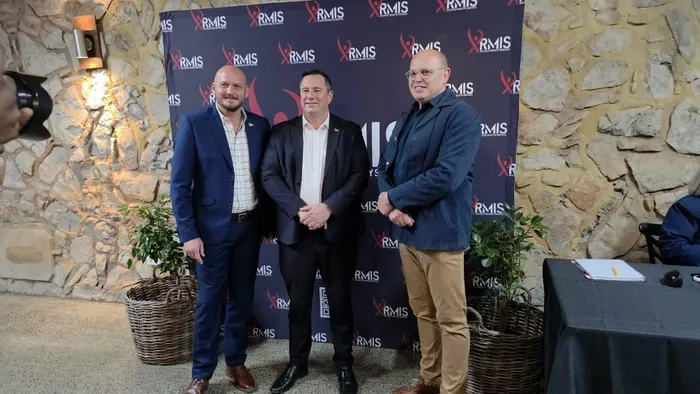RMIS launches innovative Traceability Platform to boost livestock tracking in South Africa

Red Meat Industry Services (RMIS) announced on Tuesday that it officially rolled out Phase 2 of the RMIS Traceability Platform today.
Image: Supplied
Red Meat Industry Services (RMIS) announced on Tuesday that it officially rolled out Phase 2 of the RMIS Traceability Platform today. RMIS at the launch said that this will bring South Africa’s red meat industry closer to full livestock traceability, improve disease response and support market access as South Africa deals with Foot and Mouth Disease outbreak.
RMIS said that the event was attended by the Minister of Agriculture, John Steenhuisen, along with representatives from organised agriculture and other key stakeholders. “It showcased the practical functionality of the platform across the value chain.”
RMIS added that to encourage inclusivity, they also introduced the RMIS Movement App - a free, user-friendly tool developed for producers who are not yet using digital livestock management systems. “Phase 2 introduces API integration between the RMIS Traceability Platform and several digital livestock management systems used across the value chain.” These include:
- Farm-level: Benguelasoft, Logix, AIMS, Datamars
- Auction: FlexiAuction
- Feedlot: Gigalot, Pointr Software
- Abattoir: Matrix Software
RMIS added that with the launch of Phase 2, the RMIS Traceability Platform now offers practical solutions to some of the industry’s most persistent challenges: Abattoir-level traceability: Carcasses can now be tracked back to their origin. Export compliance: Enhanced data integrity strengthens compliance with export market protocols, supporting South Africa’s market access. Improved disease response: The platform helps trace outbreaks more quickly, giving the industry faster insight into where and how diseases are spreading.
RMIS also unveiled the RMIS Movement App, a user-friendly tool designed for producers who are not yet using a digital livestock management system. “The app enables any registered production unit to record animal movements directly from their Global Location Number (GLN). It is focused solely on movement recording, not production data, and forms part of RMIS’s goal to build an inclusive and accessible national traceability network.”
Agricultural Business Chamber (Agbiz) CEO Theo Boshoff said livestock traceability is absolutely vital for our industry to unleash the economic potential of our livestock industry. “Biosecurity has been a challenge for the industry. Diseases such as Foot and Mouth occur naturally in South African regions where wildlife abound (such as the lowveld adjacent to the Kruger National Park). It is for this reason that the movement of livestock is regulated in South Africa to stop these diseases from spreading.”
Boshoff added that traceability is required by the value chain to know exactly where each animal came from, so as to prevent the transmission of diseases. “Without traceability, we may struggle to keep our industry biosecure and without biosecurity, we will not be able to realise its full economic potential. Its importance cannot be underestimated and it is for this reason that a livestock traceability system is prominent in our Agricultural and Agro-processing Master Plan.”
Francois Rossouw, the CEO of Southern African Agri Initiative (Saai), said national traceability is essential. “You can’t do rapid traceback or credible certification without clean, standardised movement data from farm to abattoir. RMIS’s Phase 2 finally stitches together multiple systems via APIs, uses GLNs to anchor locations, and even adds a free movement-logging app for producers who aren’t on digital herd software; those are the right building blocks.”
Rossouw added that traceability is only as strong as coverage and compliance: if it’s not used widely and consistently, it becomes a half-map that gives false confidence. “It will help, mainly by speeding up traceback, ring-fencing, and communication. Faster, clearer movement histories can shave days off an outbreak response. But traceability is just one pillar. FMD control still hinges on proper, enforced movement restrictions, competent on-the-ground monitoring, and farmer compliance.”
Minister of Agriculture John Steenhuisen said the government can’t manage disease control alone. “The government has to partner with the sector and the beauty of a system like this is that we can build trust from the ground up. It is good news to have a system that has been built from the ground up which the Government can take hands with to be able to make the industry standard across the board.”
Steenhuisen said a lot of measures put in place failed to take into account the complexities of rural and traditional farming areas. “This system takes into account all red meat farmers whether you are an exporter, larger feedlot or small-scale farmers; you can use the system with confidence. There is no desire for the Government to control your data and the data collected belongs to the industry and will allow the Government to extract data we need to get on top of Foot and Mouth disease. We have not won the war on FMD and we will not win it unless we move to a new way of doing things.”
BUSINESS REPORT